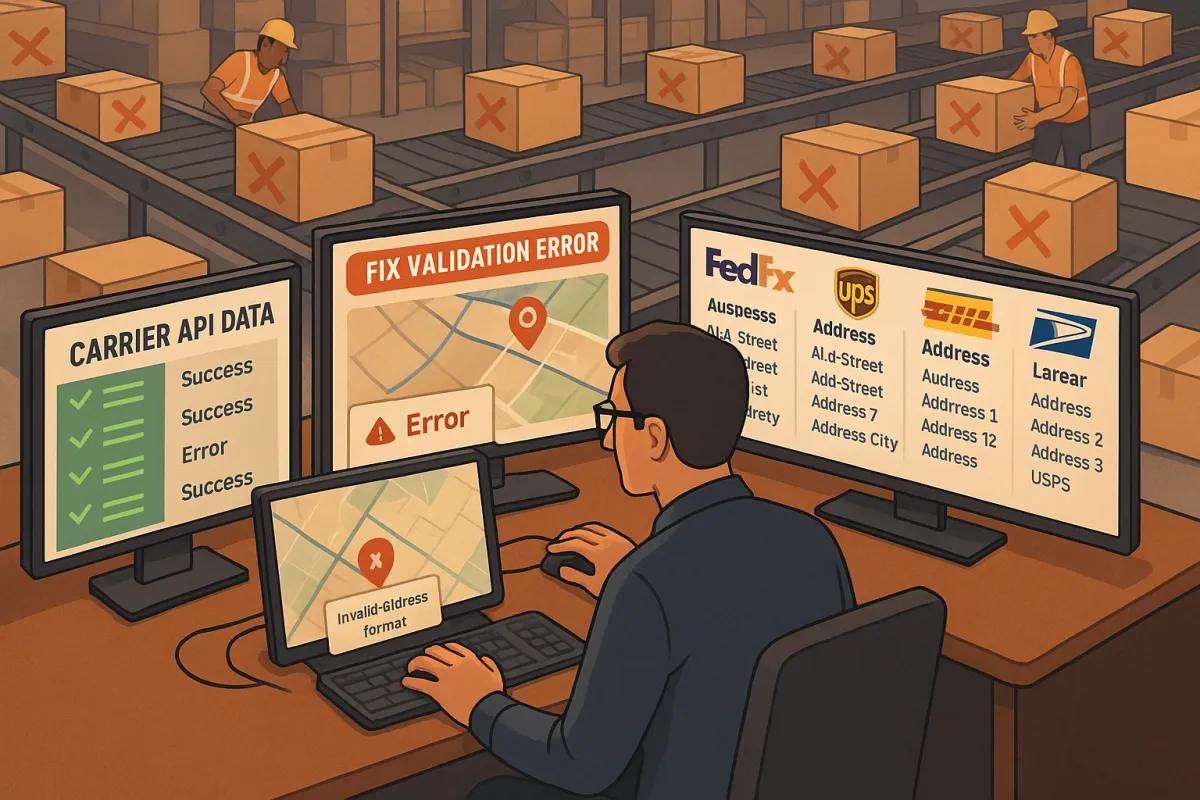Carrier API Data Validation: Essential Rules and Strategies to Prevent Shipping Disruptions

Last month, I watched a major European retailer lose €180,000 in revenue during Black Friday because their DHL Express API integration failed validation on address formats. The shipments went through, but delivery attempts failed at a 23% rate. Their operations team spent the following week manually calling customers and rebooking orders.
Sound familiar? Missing input validation is one of the most common patterns that keeps reappearing in API implementations, and these issues often stem from inconsistent coding practices and missing security controls. When it comes to carrier API data validation, poor data quality doesn't just create technical headaches—it directly impacts your bottom line through failed deliveries, frustrated customers, and emergency manual interventions.
This guide covers the specific validation strategies you need to prevent shipping disruptions across multiple carrier connections. You'll learn how to implement robust validation rules, handle real-time API failures, and build monitoring systems that catch problems before they reach your customers.
Common Data Quality Problems in Carrier APIs
Missing shipping addresses or invalid data fields are common causes of carrier rejections and delivery delays. After working with over 200 carrier integrations, I've seen the same validation failures repeatedly:
Address validation inconsistencies plague most implementations. FedEx, UPS, DHL, and USPS stand among the world's widely adopted shipping APIs, but each handles address formats differently. UPS requires postal codes in specific formats for Canada (K1A 0A6) while DHL accepts the same address with or without spaces. FedEx's API rejects addresses with apartment numbers in the wrong field, while UPS processes them successfully.
Rate calculation mismatches create constant operational friction. DHL eCommerce Europe returns different dimensional weight calculations than DHL Express for identical packages. UPS Ground and UPS SurePost APIs sometimes return conflicting rates for the same shipment parameters. These discrepancies force manual review of every automated booking.
Tracking status misclassifications lead to customer service nightmares. FedEx reports "Delivered" while the package sits at a local facility. DHL shows "In Transit" for packages that cleared customs days ago. Each platform has its own interface, rate structures, and limitations, increasing the risk of human error and inconsistent customer experiences.
Phone number formats vary wildly between carriers. Some APIs accept international formats (+44 20 7946 0958) while others require domestic formatting only. Businesses and developers rely on accurate phone number validation to ensure seamless communication and fraud prevention, and integrating a validate phone number API can improve user verification, enhance data quality, and reduce fake sign-ups.
Building Pre-Integration Validation Rules
The most effective validation happens before data ever reaches carrier APIs. Implement these validation layers to catch errors at the source:
Geographic validation rules prevent costly API rejections. Build validation that checks postal codes against country standards—UK postcodes follow specific patterns (SW1A 1AA), while German codes use five digits (10115). Validate city names against carrier-specific databases since DHL recognizes "Sankt Petersburg" while FedEx requires "Saint Petersburg" for Russian deliveries.
Service availability checks eliminate booking failures. Not every carrier services every route—UPS doesn't deliver to post office boxes in rural areas, while FedEx Ground won't handle hazardous materials. Build validation rules that cross-reference destination codes with carrier service matrices before allowing booking attempts.
Package dimension validation prevents surprises. Each carrier has weight and size restrictions that vary by service level. FedEx Express allows packages up to 68 kg while FedEx Ground accepts 70 kg. DHL Express limits single pieces to 2.44 meters in length, but DHL Freight handles longer items. Validate these constraints upfront.
Currency and customs validation saves international shipment headaches. Different carriers require customs values in different currencies. Many APIs have built-in features for generating compliance documents and reports required for customs, regulatory authorities, and auditing purposes. Validate that currency codes match destination country requirements and that customs descriptions meet carrier-specific character limits.
Solutions like Cargoson handle pre-integration validation automatically, alongside platforms like nShift and FreightPOP. However, nShift has 1,000+ true carrier API/EDI connections primarily focused on parcel carriers, but adding new carrier API integrations can cost €5,000-€10,000 each and take months to implement.
Real-Time Data Validation During API Calls
Even with solid pre-integration validation, carrier APIs throw curveballs during live operations. Implement real-time validation that detects and handles errors as they occur:
Rate response validation catches pricing anomalies immediately. Build checks that flag rate responses outside expected ranges—if DHL suddenly quotes €2.50 for a 20kg package from Berlin to Paris, something's wrong. Compare returned rates against historical averages and flag outliers for manual review before booking.
Here's a validation pattern for DHL MyDHL API responses: ```javascript function validateDHLRateResponse(response) { const baselineRate = getHistoricalAverage(response.route, response.weight); const variance = Math.abs(response.totalPrice - baselineRate) / baselineRate; if (variance > 0.3) { throw new ValidationError('Rate variance exceeds 30% threshold'); } if (!response.deliveryTime || response.deliveryTime > 14) { throw new ValidationError('Invalid delivery time estimate'); } } ```
Tracking milestone verification ensures status updates make logical sense. Build validation that checks milestone sequences—packages can't be "Delivered" before being "Out for Delivery." Whenever an order crosses a specific milestone, it immediately transfers the information to the integrated systems, which means you don't need to juggle multiple platforms to get shipment updates.
Error code interpretation varies between carriers. FedEx returns specific error codes (10001 for invalid postal code), while UPS uses different numbering (110971 for the same issue). Build mapping tables that normalize error responses across carriers for consistent handling.
Delivery confirmation validation prevents false completions. Some carrier APIs mark packages "Delivered" when they reach local facilities, not customer addresses. Cross-reference delivery confirmations with GPS coordinates or signature requirements to validate actual completion.
Platforms like MercuryGate and Cargoson include built-in real-time validation, but each handles error scenarios differently based on their carrier relationships.
Post-Integration Data Quality Monitoring
Continuous monitoring provides insights that prevent future validation failures and identifies systemic data quality issues:
Validation failure rate tracking shows which carriers and API endpoints cause the most problems. Track failure rates by carrier, service type, and destination to identify patterns. If DHL Express API failures spike on Mondays, investigate their system maintenance schedules.
Set up automated dashboards that track key metrics: - API response time variations - Rate calculation accuracy compared to invoiced amounts - Tracking milestone completeness rates - Address validation success percentages - Documentation generation failure rates
Data consistency monitoring catches drift over time. Compare the same API calls across carriers to identify inconsistencies. If UPS and FedEx both quote similar routes, their rates should correlate. Divergence indicates data quality issues with one provider.
A reliable API should have a high uptime percentage and consistent data accuracy, as downtime or inconsistent results can disrupt business operations and lead to lost revenue. Monitor API availability and response quality continuously.
Solutions like Blue Yonder and Manhattan Active include comprehensive monitoring capabilities. Cargoson provides real-time monitoring dashboards that track validation metrics across all connected carriers without additional setup costs.
Automated alerting prevents small issues from becoming major problems. Set thresholds for validation failure rates (>5% warrants investigation) and response time degradation (>3 second delays indicate problems).
Handling Validation Failures and Error Recovery
When validation fails, robust error handling prevents operational disruption and maintains customer experience:
Fallback mechanisms keep operations running during API failures. If FedEx's rate API returns errors, automatically failover to UPS and DHL for pricing. Build carrier priority lists based on service reliability and cost structures for each route.
Implement retry logic with exponential backoff for temporary failures. Many carrier APIs experience brief outages during maintenance windows. Retry failed requests after 1 second, then 5 seconds, then 15 seconds before escalating to manual intervention.
Manual validation triggers handle edge cases that automated systems can't resolve. Flag shipments with unusual characteristics (oversized packages, remote destinations, hazardous materials) for human review before submission to carrier APIs.
Error logging provides crucial debugging information. Log the exact API request, response, validation rule that triggered the failure, and timestamp. Include order IDs and customer information for quick resolution. This data becomes invaluable when carriers change their API specifications.
Customer communication during failures maintains trust. When validation failures prevent automated booking, send immediate notifications with alternative shipping options rather than leaving customers wondering about order status.
Here's specific error handling for common carrier API issues: - FedEx Error 10001 (Invalid postal code): Trigger address validation API call before retry - UPS Error 110971 (Same issue): Apply same address validation logic - DHL Error 1101 (Service not available): Automatically suggest alternative DHL services - Generic timeout errors: Implement exponential backoff with circuit breaker pattern
Testing and Validation Best Practices for Multi-Carrier Environments
Comprehensive testing validates your validation rules work correctly across different carrier APIs and edge cases:
Sandbox testing protocols let you test validation logic without real shipments. Most carriers provide test environments with predictable responses. Build test suites that cover common validation scenarios: invalid addresses, oversized packages, restricted destinations, and service unavailability.
Load testing during peak seasons reveals validation bottlenecks. Different carriers, fluctuating rates, lack of real-time tracking create international shipping headaches, which is exactly why Shipping Integration with FedEx, UPS, and DHL is no longer optional. Test your validation rules under Black Friday traffic levels to ensure they don't become performance bottlenecks.
A/B testing validation rules optimizes accuracy vs. performance trade-offs. Test stricter validation rules against more permissive ones to find the right balance. Overly strict validation blocks legitimate shipments, while loose validation allows bad data through.
Cross-carrier validation testing ensures consistency. Send identical shipment parameters to multiple carrier APIs and validate that your system handles the different response formats correctly. UPS returns rates in cents while DHL uses currency decimals—your validation should normalize these differences.
Integration testing with actual carrier APIs catches issues that sandbox environments miss. Carriers sometimes update production APIs without corresponding sandbox changes. Schedule regular integration tests against live carrier APIs using test shipments.
Platforms like Alpega and E2open provide testing frameworks for multi-carrier scenarios. Cargoson includes built-in testing capabilities alongside ShipStation and EasyPost, allowing validation rule testing across all connected carriers from a single interface.
Document your validation rules and test scenarios thoroughly. When carrier APIs change (and they will), clear documentation helps identify which validation rules need updates. Include examples of valid and invalid inputs for each rule.
Implementation Roadmap
Start with pre-integration validation for your highest-volume carriers—typically this means FedEx, UPS, and DHL for most European shippers. Focus on address and service validation first, then expand to rate and tracking validation.
Implement real-time validation gradually, beginning with rate anomaly detection since pricing errors cause the most immediate business impact. Add tracking and delivery validation once your rate validation is stable.
Build monitoring dashboards before you need them. Data quality problems compound over time, and early visibility prevents major operational disruptions. Set up basic failure rate tracking first, then add more sophisticated metrics as your system matures.
Choose your validation platform carefully. Cargoson, while offering similar services to nShift, is better suited for manufacturing, retail, and 3PL companies, providing broader functionality, such as multi-carrier comparisons, document generation, and support for all freight types. Consider whether you need a specialized multi-carrier platform or can build validation into your existing TMS.
Remember: robust carrier API data validation isn't just about preventing errors—it's about building a logistics system that scales with your business and adapts to the constant changes in carrier requirements. The investment in proper validation pays dividends through reduced manual intervention, higher customer satisfaction, and smoother operations during peak shipping periods.
